The Dominican Republic is renowned as an affordable beach destination, and brims with package tours and enticing all-inclusive resorts. It's also a captivating blend of culture, history, and stunning natural beauty. The main tourist magnets are the areas around Puerto Plata, Punta Cana, La Romana, and Samaná. However, the country's cultural jewel is the capital, Santo Domingo: a UNESCO World Heritage Site.In addition to well-developed beach resorts and world-class golf courses, the Dominican Republic is home to vast coral reefs, waterfalls, jungles, secluded islands, pine forests, and the highest peaks in the Caribbean. Thanks to these diverse ecosystems, recreational opportunities abound. Adventure seekers head to the mountains to raft the white waters of the Yaque del Norte River. The rugged alpine terrain also lures hikers and bikers with its many mountain trails. Along the coast, water lovers can snorkel, dive, kayak, kite board, sail, and surf.
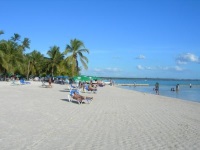
The small seaside town of Boca Chica lies just east of Santo Domingo on the Avenida de las Americas, and is a popular escape from city life. Its calm, crystal-clear waters make for superb swimming conditions, and its golf and seafood scenes are highly recommended. Visitors may also enjoy the destination's yacht clubs. Along with its azure waters and pristine white sands, Boca Chica's short distance from the island's capital city makes it the most popular beach in the Dominican Republic, especially on weekends and holidays. Boating visitors can anchor off Boca Chica's two islets, La Piedra and La Matica.
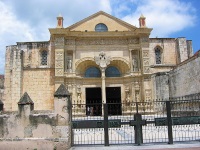
Inside the Colonial City stands the oldest cathedral in the western hemisphere. Consecrated in 1541, it is still used to this day. Its mix of late-Gothic and Renaissance elements provide a beautiful example of Spanish Renaissance architecture, with its golden coral facade and Gothic interior. Its walls have seen a great deal of history, including the coming of Sir Francis Drake, who captured Santo Domingo in 1586 and held the town for ransom. Interestingly, the remains of Christopher Columbus were once housed at the cathedral, before their final resting place in the Faro a Colon. The cathedral's treasury has an excellent art collection of ancient woodcarvings, furnishings, funerary monuments, silver, and jewellery, which visitors can explore.
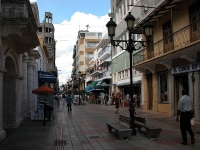
Known as the Colonial City, the historic enclave of Santo Domingo covers only one square mile (3 sq km), but has dozens of historical sites and buildings behind its walls. Visitors will find parks, forts, churches, plazas, statues, palaces and monuments. A walking tour of these fascinating buildings takes at least three hours, and proceeds over cobbled streets where Christopher Columbus, Fernando Cortez and Francis Drake once walked. The city's main street, Calle de Las Damas, is the oldest street in the New World. Regarding sights, must-sees include the House of Cord, which is the oldest European building in the Americas, and the Alcazar Palace, where Christopher Columbus' son Diego once lived. It was built between 1510 and 1514.
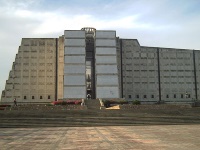
The monument was built on the eastern shore of the Ozama River in the early 1990s, to commemorate both Santo Domingo's status as the oldest European city in the Americas, and the 500th anniversary of Columbus' arrival in the New World. The building is 680 feet (210m) long, and built in the shape of a cross. It houses what are claimed to be the remains of Columbus himself, and is fitted with intense lights that project the image of the cross into the sky at night. The monument was designed by Scottish architect J.L. Gleave, who won an international competition with his plans for the lighthouse. The building is also the repository for numerous documents and artefacts associated with the early Spanish colonial times.
Address : Av. España
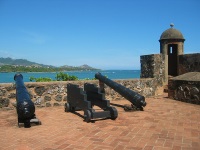
The only remnant of Puerto Plata's Spanish Colonial past is a small fort. Built in the mid-16th century to protect the bay against pirates, it features a moat, and a collection of historical artefacts in a small museum. The fort never saw great battle, though, and was mostly used as a prison. An ocean-side road known as the Malecon lies to the east of the fort, and has many cafes and roadside vendors. It is a popular promenade for walks beside the beach.
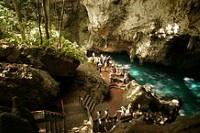
Located on the east bank of the Ozama River, the 'Three Eyes' park is a surreal experience for visitors. The attraction is actually a series of huge natural caves that contain fresh-water lagoons. One is a sulphuric lake rumoured to be bottomless. A volcanic crater contains it. The caves are also festooned with stalactites and stalagmites. History lovers should note that the pre-Columbian Taino Indians used the caves for religious ceremonies. The site is currently one of the most-visited tourist attractions in the country. The caves are open from 8.30am to 5.30pm, and are illuminated at night by many coloured lights.
Address : Av. Las Américas
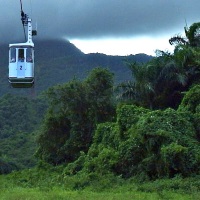
Towering over the city of Puerto Plata is the 2,600 feet (792m) Mount Isabel de Torres, which is a popular tourist attraction in its own right. Visitors can take a spectacular seven-minute cable car ride up the mountainside to explore the summit. The botanical garden at the top boasts an amazing array of flora and fauna, as well as a cruciform statue of Jesus Christ. The statue replicates Rio de Janeiro's Christ the Redeemer. There is also a restaurant, from which diners can enjoy breathtaking views of the city and coastline.
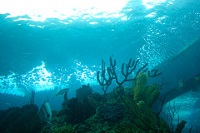
One of the better aquariums in the Caribbean lies about a mile east of the Columbus Lighthouse monument, and offers visitors guided glimpses of the region's diverse, colourful sea life. The open, airy National Aquarium is equipped with a clear-glass sea-tunnel that makes viewing the enclosed sea life an awesome experience. Visitors can see everything from angelfish to sharks. The attraction is just a short drive out of the city.
Address : Av. España 75, Sans Soucí
Website : www.acuarionacional.gob.do
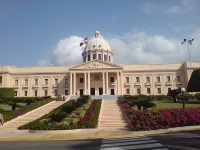
The vast green square in the heart of Santo Domingo serves as the city's cultural and artistic showcase. It's fronted by a cluster of four museums and houses the city's most important cultural venues, including the Teatro Nacional (National Theater). The square also boasts the likes of the Palacio Nacional, which houses the Presidency of the Dominican Republic; the Palacio de Bellas Artes (Palace of Fine Arts), a neoclassical building that is the permanent home of the country's National Symphony Orchestra; and the Boulevard 27 de Febrero, a pedestrian promenade located on the busy Avenida 27 de Febrero, which displays works of art from prominent Dominican artists and sculptors. The museums in the plaza are the Museum of Modern Art, the Museum of History and Geography, the Museum of Natural History and the Museum of Dominican Man. The National Theatre runs a full programme of opera, ballet, music and drama productions year round, and visitors should certainly take in a show to round off their cultural experience in Santo Domingo.
Address : Avenida Maximo Gomez, Santo Domingo
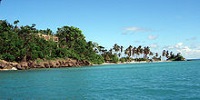
Jutting into the Atlantic like a finger, the beautiful Samaná Peninsula lies in the east of the island and is a remote area with deserted white-sand beaches, palm forests and clear, calm waters. Hidden towns and fishing villages, brightly painted Dominican homes, and a Mediterranean-influenced atmosphere characterise its communities. Mountain passes with winding roads dominate the interior. Visitors will enjoy their cool waterfalls, lush vegetation and magnificent views. The Samaná Peninsula is also known for the migration of humpback whales. This happens between January and March every year, when whales enter the sheltered warm waters along its coast.

Travel Guide powered by Word Travels, copyright © 2023 Globe Media Ltd. By its very nature information in this travel guide is subject to change at short notice and travellers are urged to verify information on which they're relying with the relevant authorities. Neither Globe Media Ltd nor Travel Vogue can accept any responsibility for any loss or inconvenience to any person as a result of information contained above.